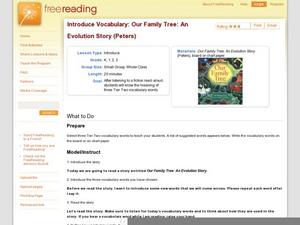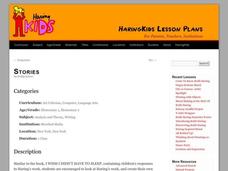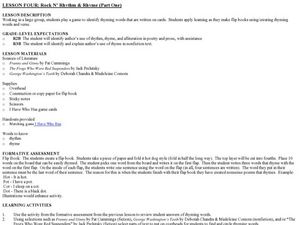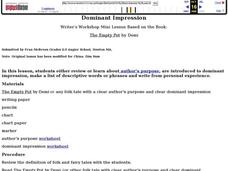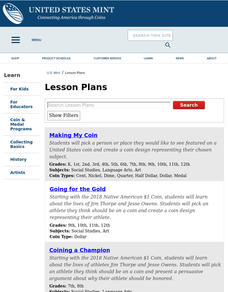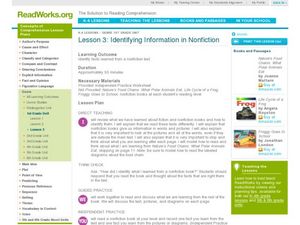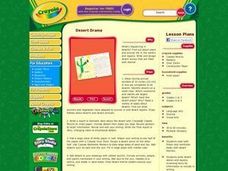Curated OER
Introduce Vocabulary: Our Family Tree: An Evolution Story (Peters)
Lisa Peters presents macroevolution as a large-scale family tree in her book Our Family Tree: An Evolution Story. She suggests the process from single-celled organisms to modern-day humans, and learners explore new vocabulary...
Curated OER
Introduce Vocabulary: Sorting (Pluckrose)
Find guidance to introduce math vocabulary in context using Henry Pluckrose's book Sorting. This text is an excellent cross-curricular resource for budding readers. Before starting, review some new vocabulary words: collect, common,...
Curated OER
Stories
Students examine the book, I Wish I Didn't Have to Sleep, and examine Haring's work. They create stories about Keith Haring's pictures.
Curated OER
Rock N Rhythm & Rhyme (Part One)
Students make flip books of rhyming words and match words together that are on cards. In this rhyming lesson plan, students read books and read individual words to identify rhyming words.
Curated OER
Adventures in Alice
Students create a haiku and illustrate it on the computer. For this haiku lesson plan, students review the history of the haiku while they are outside and then write their own. Students then use a computer program to illustrate their poem.
Scholastic
A House for Hermit Crab
Engage young marine biologists in a reading of Eric Carle's A House for Hermit Crab with a fun hands-on activity. Given a set of clipart images of the different aquatic animals that appear in the book, children identify each one...
Curated OER
Wombat Stew
In this review of Wombat Stew worksheet, students write a review in plot form about the story Wombat Stew. Students fill in 8 components of plot for this story.
Curated OER
After The End...
Students create a few different endings to stories they are familiar with. In this writing lesson plan, students listen to the story, "The Giant Jam Sandwich," and see how a different ending changes the whole story. Each student chooses...
Curated OER
Pinky and Rex and the Just Right Pet
Students engage in reading comprehension activities for the story "Pinky and Rex and the Just Right Pet". For this reading comprehension lesson, students make prediction drawings before reading the story, create new illustrations for...
Curated OER
Review of the Five Senses
Students investigate the five senses. In this human biology activity, students are given five items and identify which items match best with each of the senses. Students use objects such as a rock, hard candy, and a flower.
Curated OER
My Best Handwriting Book 2 Pre-Cursive
In this printing letter F activity, students learn to form upper and lower case DeNelian letter Ff. Students trace letters and words before practicing their own letters.
Curated OER
Dominant Impression: Writer's Workshop Mini Lesson Based on the book: The Empty Pot by Demi
Students investigate folk and fairy tales. In this reading comprehension lesson, students review the concept of author's purpose after listening to "The Empty Pot" by Demi. Students also explore descriptive words and dominant impression...
Curated OER
Coin-Shaped Books
Pupils review United States coins throughout history, and create shape books for their favorite coins. Each book contains text and illustrations created by Students.
Curated OER
Thumbs Up to a Good Book!
Second graders read a short story and discuss whether they would give it a thumbs up or down and why. students write a group review on that story supporting why they gave it the up or down thumb. They choose and read a short story and...
Curated OER
Books Have Feelings Too
Second gradersincrease their reading fluency and expressiveness through the use of various strategies. After reviewing decoding and rereading, 2nd graders complete an initial read of a novel text without expression. Each student reads a...
Curated OER
Friendly Letter
Students write friendly letters. In this friendly letters lesson, students write a friendly letter on the given template after being given direct instruction on how to write a friendly letter.
Curated OER
Louisiana Cinquains
Students enhance their understanding of parts of speech by writing a cinquain poem about Louisiana. In this cinquain poem lesson, students read example cinquain poems and study the format for a cinquain poem. Students create a class poem...
Curated OER
Gold Fever
Students read the story Gold Fever about the Gold Rush and write journal entries as if they were miners. In this Gold Rush lesson plan, students also pull out rocks from a back, and if they pick a gold one, they have struck it rich!
Teaching Tolerance
Community Bulletin Board
A project-based lesson has pupils create a bulletin board to share artwork, nonfiction articles, and messages based on social justice themes. The finished board is displayed in the community to create a place for discussion.
Curated OER
Identifying Information in Nonfiction
Second graders investigate information in non-fiction texts. They review the features of a non-fiction text and read the book Nature's Food Chains: What Polar Animals Eat. Pupils discuss the text features and write down one fact they...
Curated OER
Desert Drama
Students read both fiction and nonfiction books with desert themes. Then they write desert stories and reports, reviewing texts for information to include in writing. Students also design desert scenes with details and setting elements...
Curated OER
Only the Facts
Practice the strategy of summarizing to gain meaning and knowledge from an informational text. Young readers highlight supporting details and main ideas, and then they use this to summarize two articles: "The Great Quake" and "What...
Curated OER
Build Mastery: Cause and Effect
After you've begun identifying the cause and effect relationship within literature, it's time to give scholars some independent practice. Review the concept before handing out this graphic organizer. Learners use the book they are...
Curated OER
Author's Purpose
A simple activity for young readers, this introduces the idea of author purpose. Learners analyze various types of texts (newspaper articles, magazines, books, advertisements, etc.) and determine if the author's purpose for writing was...
